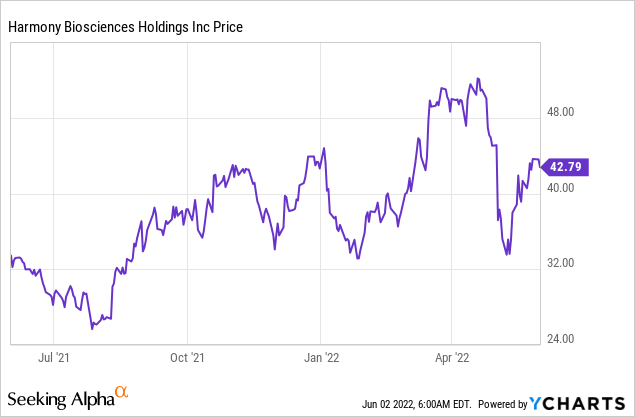
02 Jun Pitolisant is a “portfolio in a product” opportunity!
Harmony Biosciences, Inc. (NASDAQ: HRMY) is a commercial-stage biopharmaceutical Company developing novel therapeutics for rare and orphan diseases, focusing on central nervous system disorders. Pitolisant, its lead product candidate, is a first-in-class histamine 3 (H3) receptor antagonist/inverse agonist that can help treat excessive daytime sleepiness (EDS) and cataplexy. The drug acts by promoting the activity of histaminergic neurons in the brain that can help regulate the sleep-wake cycle.
Harmony Biosciences, Inc. (NASDAQ: HRMY)
Market Cap: $2.53B; Current Share Price: 42.79 USD
Data by YCharts
Strength
The FDA granted the drug an orphan drug, fast track, and breakthrough therapy designation; this was followed by the acceptance of a New Drug Application (NDA) and a priority review for the product in February 2019. The Company scored an FDA approval for Wakix (pitolisant) in August 2019 and consequently gained approval for using WAKIX® (pitolisant) to treat cataplexy in adult patients with narcolepsy in October 2020.
Pitolisant has the potential to be a “portfolio” in a product opportunity, and the Company intends to leverage its novel mechanism of action to address the unmet needs of people suffering from rare neurological diseases.
Pitolisant was designed and developed by the Bioprojet Societe Civile de Recherche (Bioprojet) and was approved by the European Medicines Agency in 2016. Harmony acquired an exclusive license to develop and commercialize pitolisant in the United States from Bio project through a $270 million equity financing deal.
March 2022 was one of the strongest months of performance in top-line prescription demand, and new patients start in a year as per John Jacobs, President and Chief Executive Officer of Harmony. The growth is expected to remain strong for the remainder of the year, driven by demand and growth opportunities in narcolepsy. The Company is actively seeking to expand its portfolio through significant acquisitions of neurological assets that are either early or late stage with the potential to launch both during and after the waking life cycle.
The average number of patients using WAKIX grew by approximately 3,900 in the first quarter, partly due to anticipated once-yearly seasonal dynamics of Managed Care reauthorizations and Patient Assistance Program re-verification during the first quarter of each year.
The Company is also developing HBS-102, a melanin-concentrating hormone receptor 1 (MCHR1) antagonist that targets melanin-concentrating hormone neurons in the hypothalamus that regulate several vital functions such as feeding, energy balance, metabolic functions, rapid eye movement (REM), sleep, and mood and behavioral processing. The candidate is undergoing pre-IND enabling studies in Prader-Willi syndrome.
Harmony is developing a pipeline of products that target diseases mediated by histamine and the H3 receptor. Some indications in which Pitolisant is being evaluated include a phase 3 trial in idiopathic hypersomnia, a Phase 3 trial in pediatric narcolepsy, a phase 2 trial in Prader-Willi Syndrome, and a Phase 2 in myotonic dystrophy.

Image Source: Company
The Company intends to extend the application of Pitolisant in other orphan and rare neurological conditions.
Weakness
The average discontinuation rate is between 30% and 50 for products in this category at a 12-months range. Pitolisant falls in the middle of this range, but the Company claims it is consistent with expectations from patients and healthcare professionals.
Furthermore, the Company faced headwinds in the form of government payors as government-insured patients did not continue the treatment as they could not meet the financial need criteria through third-party support. Some patient assistance program patients did not meet program eligibility requirements and had to discontinue treatment. Government pay is close to 15% of the overall payer mix, a significant opportunity for the Company.
Opportunity
Narcolepsy is a sleep disorder that affects 1 in 2000 individuals. It is caused by the loss or damage of a chemical named Hypocretin present in the hypothalamus, responsible for regulating sleep cycles and alerting the brain. This disorder is characterized by difficulty staying awake, disruption in sleep-wake processes, sleep paralysis, disturbed sleep, insomnia, vivid hallucinations, and cataplexy (Partial or total loss of muscle control).
The National Institute of Neurological Disorders and Strokes (NIH) estimates that between 135,000 to 200,000 people are afflicted with this condition in the U.S alone, with a substantial number of cases remaining undiagnosed. There is no definitive cure for this condition; however, medication and behavioral changes help manage the symptoms from interfering with those affected social, psychological, and cognitive functioning and development.
Research shows that Narcolepsy may be caused due to a combination of factors such as autoimmune disorders, genetic disposition or family history, and sudden traumatic brain injuries that damage the hypothalamus. The diagnosis involves a physical examination and specialized tests such as Polysomnogram (PSG or sleep study) and multiple sleep latency tests (MSLT). Once diagnosed, the patient will have to use Modafinil, a central nervous system stimulant, or amphetamine-like stimulants such as methylphenidate, antidepressant drugs that can control cataplexy, and the highly regulated gamma hydroxybutyrate or GHB.
The need of the hour is better therapeutics that can overcome the limitations of existing treatment options, such as nausea, headaches, insomnia, and mood swings. In addition, antidepressant medication can cause weight gain, hypertension, and sexual dysfunction.
Threat
However, Clinical Trials are fraught with risk and uncertainty. A diverse pipeline will help mitigate the risk in case of adverse results or the failure to muster a regulatory approval. The success of its clinical trials will allow the Company to advance its pipeline, but it should also be prepared to face any setbacks if its ongoing trials fail to meet their endpoints.
Key Takeaways
Disclosure: I/we have no positions in any stocks mentioned, and no plans to initiate any positions within the next 72 hours.
Click here to please visit our detailed disclosure
References
https://www.harmonybiosciences.com/our-focus
https://www.ninds.nih.gov/Disorders/Patient-Caregiver-Education/Fact-Sheets/Narcolepsy-Fact-Sheet
https://www.harmonybiosciences.com/science
https://ir.harmonybiosciences.com/static-files/3bac4c3e-5f3f-4772-bf25-ca4ac45ca7eb





No Comments